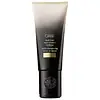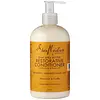What's inside
What's inside
 Key Ingredients
Key Ingredients

 Benefits
Benefits

 Concerns
Concerns

 Ingredients Side-by-side
Ingredients Side-by-side

Water
Skin ConditioningCetearyl Alcohol
EmollientBehentrimonium Chloride
PreservativeDimethicone
EmollientCetyl Alcohol
EmollientStearamidopropyl Dimethylamine
EmulsifyingAmodimethicone
Hydrogenated Ethylhexyl Olivate
EmollientCetyl Esters
EmollientPropanediol
SolventParfum
MaskingPolysorbate 60
EmulsifyingGuar Hydroxypropyltrimonium Chloride
Skin ConditioningButyrospermum Parkii Butter
Skin ConditioningDimethiconol
EmollientHydrogenated Olive Oil Unsaponifiables
EmollientHydroxyethylcellulose
Emulsion StabilisingPanthenol
Skin ConditioningGlycerin
HumectantDisodium EDTA
C11-15 Pareth-7
EmulsifyingLaureth-9
EmulsifyingCetrimonium Chloride
AntimicrobialTrideceth-15
EmulsifyingTrideceth-3
EmulsifyingPentaerythrityl Tetra-Di-T-Butyl Hydroxyhydrocinnamate
AntioxidantBHT
AntioxidantTrideceth-12
EmulsifyingPolysilicone-15
UV FilterJojoba Esters
EmollientQuaternium-95
UV AbsorberAcetic Acid
BufferingAdansonia Digitata Seed Oil
EmollientArgania Spinosa Kernel Oil
EmollientCaffeine
Skin ConditioningButylene Glycol
HumectantMoringa Oleifera Seed Oil
EmollientAlcohol
AntimicrobialCamellia Sinensis Leaf Extract
AntimicrobialChondrus Crispus Extract
Skin ConditioningCitrus Limon Fruit Extract
MaskingJasminum Officinale Flower Extract
MaskingPassiflora Incarnata Extract
AstringentRibes Nigrum Fruit Extract
AstringentCystine Bis-Pg-Propyl Silanetriol
Skin ConditioningHydrolyzed Vegetable Protein Pg-Propyl Silanetriol
Skin ConditioningHydrolyzed Vegetable Protein
Skin ConditioningBromelain
Skin ConditioningCitrus Aurantium Bergamia Leaf Extract
AstringentLeontopodium Alpinum Extract
Skin ConditioningNiacinamide
SmoothingSantalum Album Extract
CleansingAmber Extract
Skin ConditioningCitrullus Lanatus Fruit Extract
Skin ConditioningTocopherol
AntioxidantVegetable Amino Acids
Skin ConditioningCupressus Sempervirens Seed Extract
PerfumingOryza Sativa Seed Protein
AntioxidantLeuconostoc/Radish Root Ferment Filtrate
AntimicrobialPhytic Acid
Oryza Sativa Extract
AbsorbentCitrulline
Skin ConditioningGluconolactone
Skin ConditioningBiotin
AntiseborrhoeicTocopheryl Acetate
AntioxidantLitchi Chinensis Pericarp Extract
Skin ConditioningMoringa Oleifera Seed Extract
Skin ConditioningCalcium Gluconate
HumectantSodium Phosphate
BufferingDisodium Phosphate
BufferingBenzyl Alcohol
PerfumingEthylhexylglycerin
Skin ConditioningPhenoxyethanol
PreservativeCaprylyl Glycol
EmollientIsopropyl Alcohol
SolventPotassium Sorbate
PreservativeChlorphenesin
AntimicrobialSodium Benzoate
MaskingCitric Acid
BufferingLimonene
PerfumingHexyl Cinnamal
PerfumingWater, Cetearyl Alcohol, Behentrimonium Chloride, Dimethicone, Cetyl Alcohol, Stearamidopropyl Dimethylamine, Amodimethicone, Hydrogenated Ethylhexyl Olivate, Cetyl Esters, Propanediol, Parfum, Polysorbate 60, Guar Hydroxypropyltrimonium Chloride, Butyrospermum Parkii Butter, Dimethiconol, Hydrogenated Olive Oil Unsaponifiables, Hydroxyethylcellulose, Panthenol, Glycerin, Disodium EDTA, C11-15 Pareth-7, Laureth-9, Cetrimonium Chloride, Trideceth-15, Trideceth-3, Pentaerythrityl Tetra-Di-T-Butyl Hydroxyhydrocinnamate, BHT, Trideceth-12, Polysilicone-15, Jojoba Esters, Quaternium-95, Acetic Acid, Adansonia Digitata Seed Oil, Argania Spinosa Kernel Oil, Caffeine, Butylene Glycol, Moringa Oleifera Seed Oil, Alcohol, Camellia Sinensis Leaf Extract, Chondrus Crispus Extract, Citrus Limon Fruit Extract, Jasminum Officinale Flower Extract, Passiflora Incarnata Extract, Ribes Nigrum Fruit Extract, Cystine Bis-Pg-Propyl Silanetriol, Hydrolyzed Vegetable Protein Pg-Propyl Silanetriol, Hydrolyzed Vegetable Protein, Bromelain, Citrus Aurantium Bergamia Leaf Extract, Leontopodium Alpinum Extract, Niacinamide, Santalum Album Extract, Amber Extract, Citrullus Lanatus Fruit Extract, Tocopherol, Vegetable Amino Acids, Cupressus Sempervirens Seed Extract, Oryza Sativa Seed Protein, Leuconostoc/Radish Root Ferment Filtrate, Phytic Acid, Oryza Sativa Extract, Citrulline, Gluconolactone, Biotin, Tocopheryl Acetate, Litchi Chinensis Pericarp Extract, Moringa Oleifera Seed Extract, Calcium Gluconate, Sodium Phosphate, Disodium Phosphate, Benzyl Alcohol, Ethylhexylglycerin, Phenoxyethanol, Caprylyl Glycol, Isopropyl Alcohol, Potassium Sorbate, Chlorphenesin, Sodium Benzoate, Citric Acid, Limonene, Hexyl Cinnamal
Water
Skin ConditioningStearyl Alcohol
EmollientOlea Europaea Fruit Oil
MaskingBehentrimonium Chloride
PreservativeCetyl Alcohol
EmollientButyrospermum Parkii Butter
Skin ConditioningGlyceryl Caprylate
EmollientArgania Spinosa Kernel Oil
EmollientMacrocystis Pyrifera Extract
Skin ConditioningSimmondsia Chinensis Seed Oil
EmollientDaucus Carota Sativa Seed Oil
EmollientHydrolyzed Silk
HumectantHydrolyzed Soy Protein
HumectantAloe Barbadensis Leaf Juice
Skin ConditioningPanthenol
Skin ConditioningTocopheryl Acetate
AntioxidantDicaprylyl Ether
EmollientSodium Isostearoyl Lactylate
EmulsifyingSodium Benzoate
MaskingHydroxyethylcellulose
Emulsion StabilisingGlyceryl Undecylenate
EmollientParfum
MaskingWater, Stearyl Alcohol, Olea Europaea Fruit Oil, Behentrimonium Chloride, Cetyl Alcohol, Butyrospermum Parkii Butter, Glyceryl Caprylate, Argania Spinosa Kernel Oil, Macrocystis Pyrifera Extract, Simmondsia Chinensis Seed Oil, Daucus Carota Sativa Seed Oil, Hydrolyzed Silk, Hydrolyzed Soy Protein, Aloe Barbadensis Leaf Juice, Panthenol, Tocopheryl Acetate, Dicaprylyl Ether, Sodium Isostearoyl Lactylate, Sodium Benzoate, Hydroxyethylcellulose, Glyceryl Undecylenate, Parfum
Ingredients Explained
These ingredients are found in both products.
Ingredients higher up in an ingredient list are typically present in a larger amount.
You may know this ingredient as argan oil. Argan Oil has antioxidant, hydrating, and soothing properties.
Studies have shown argan oil can help fight again radical damage from the sun. This makes it effective at preventing hyperpigmentation.
Large amounts of vitamin E found in argan oil helps the skin retain water. Argan oil also contains fatty acids such as linoleic acid, oleic acid, and palmitic acid. It is also a good source of lipids.
Another benefit of argan oil is skin-soothing. It can help reduce inflammation-related skin symptoms.
Argan Oil is effective at regulating sebum production in pores. This can make it effective at treating hormonal acne.
Traditionally, argan oil was used for its antibacterial and antifungal properties. However, argan oil contains fatty acids that may make it not fungal-acne safe.
Argan Trees are native to Morocco.
Learn more about Argania Spinosa Kernel OilThis ingredient is a preservative and often used for it's anti-static properties. You'll most likely see this ingredient in hair conditioners.
It does not cause irritation or sensitization in leave-on products at 1-5%.
This ingredient is also known as shea butter. It is an effective skin hydrator and emollient.
Emollients help soothe and soften your skin. It does this by creating a protective film on your skin. This barrier helps trap moisture and keeps your skin hydrated. Emollients may be effective at treating dry or itchy skin.
Shea butter is rich in antioxidants. Antioxidants help fight free-radicals, or molecules that may harm the body. It is also full of fatty acids including stearic acid and linoleic acid. These acids help replenish the skin and keep skin moisturized.
While Shea Butter has an SPF rating of about 3-4, it is not a sunscreen replacement.
Shea butter may not be fungal acne safe. We recommend speaking with a professional if you have any concerns.
Learn more about Butyrospermum Parkii ButterCetyl Alcohol is a fatty alcohol. Fatty Alcohols are most often used as an emollient or to thicken a product.
Its main roles are:
Though it has "alcohol" in the name, it is not related to denatured alcohol or ethyl alcohol.
The FDA allows products labeled "alcohol-free" to have fatty alcohols.
Learn more about Cetyl AlcoholHydroxyethylcellulose is used to improve the texture of products. It is created from a chemical reaction involving ethylene oxide and alkali-cellulose. Cellulose is a sugar found in plant cell walls and help give plants structure.
This ingredient helps stabilize products by preventing ingredients from separating. It can also help thicken the texture of a product.
This ingredient can also be found in pill medicines to help our bodies digest other ingredients.
Learn more about HydroxyethylcellulosePanthenol is a common ingredient that helps hydrate and soothe the skin. It is found naturally in our skin and hair.
There are two forms of panthenol: D and L.
D-panthenol is also known as dexpanthenol. Most cosmetics use dexpanthenol or a mixture of D and L-panthenol.
Panthenol is famous due to its ability to go deeper into the skin's layers. Using this ingredient has numerous pros (and no cons):
Like hyaluronic acid, panthenol is a humectant. Humectants are able to bind and hold large amounts of water to keep skin hydrated.
This ingredient works well for wound healing. It works by increasing tissue in the wound and helps close open wounds.
Once oxidized, panthenol converts to pantothenic acid. Panthothenic acid is found in all living cells.
This ingredient is also referred to as pro-vitamin B5.
Learn more about PanthenolParfum is a catch-all term for an ingredient or more that is used to give a scent to products.
Also called "fragrance", this ingredient can be a blend of hundreds of chemicals or plant oils. This means every product with "fragrance" or "parfum" in the ingredients list is a different mixture.
For instance, Habanolide is a proprietary trade name for a specific aroma chemical. When used as a fragrance ingredient in cosmetics, most aroma chemicals fall under the broad labeling category of “FRAGRANCE” or “PARFUM” according to EU and US regulations.
The term 'parfum' or 'fragrance' is not regulated in many countries. In many cases, it is up to the brand to define this term.
For instance, many brands choose to label themselves as "fragrance-free" because they are not using synthetic fragrances. However, their products may still contain ingredients such as essential oils that are considered a fragrance by INCI standards.
One example is Calendula flower extract. Calendula is an essential oil that still imparts a scent or 'fragrance'.
Depending on the blend, the ingredients in the mixture can cause allergies and sensitivities on the skin. Some ingredients that are known EU allergens include linalool and citronellol.
Parfum can also be used to mask or cover an unpleasant scent.
The bottom line is: not all fragrances/parfum/ingredients are created equally. If you are worried about fragrances, we recommend taking a closer look at an ingredient. And of course, we always recommend speaking with a professional.
Learn more about ParfumSodium Benzoate is a preservative. It's used in both cosmetic and food products to inhibit the growth of mold and bacteria. It is typically produced synthetically.
Both the US FDA and EU Health Committee have approved the use of sodium benzoate. In the US, levels of 0.1% (of the total product) are allowed.
Sodium benzoate works as a preservative by inhibiting the growth of bacteria inside of cells. It prevents the cell from fermenting a type of sugar using an enzyme called phosphofructokinase.
It is the salt of benzoic acid. Foods containing sodium benzoate include soda, salad dressings, condiments, fruit juices, wines, and snack foods.
Studies for using ascorbic acid and sodium benzoate in cosmetics are lacking, especially in skincare routines with multiple steps.
We always recommend speaking with a professional, such as a dermatologist, if you have any concerns.
Learn more about Sodium BenzoateTocopheryl Acetate is AKA Vitamin E. It is an antioxidant and protects your skin from free radicals. Free radicals damage the skin by breaking down collagen.
One study found using Tocopheryl Acetate with Vitamin C decreased the number of sunburned cells.
Tocopheryl Acetate is commonly found in both skincare and dietary supplements.
Learn more about Tocopheryl AcetateWater. It's the most common cosmetic ingredient of all. You'll usually see it at the top of ingredient lists, meaning that it makes up the largest part of the product.
So why is it so popular? Water most often acts as a solvent - this means that it helps dissolve other ingredients into the formulation.
You'll also recognize water as that liquid we all need to stay alive. If you see this, drink a glass of water. Stay hydrated!
Learn more about Water